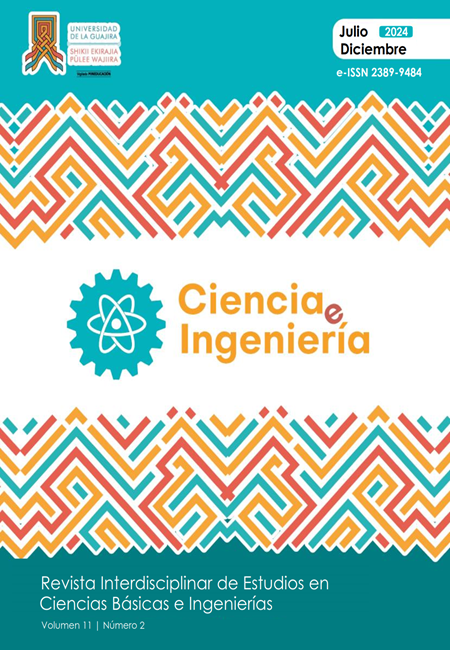Abstract
Cyanobacteria are photosynthetic microorganisms with significant biotechnological potential, given their capacity to produce a diverse array of bioactive compounds with antimicrobial, antiviral, antifungal, and anticancer properties. The present study evaluated the antimicrobial potential of cyanobacteria collected from Lake Camécuaro, Michoacán, Mexico. Isolation was performed by the serial dilution technique, and monoalgal cultures were obtained under the following conditions: room temperature, agitation at 102 rpm, and white light intensity ranging from 14,86 to 21,62 µmol m-2 s-1. For morphological identification, dichotomous keys were employed, while for molecular identification, a region of the gene coding for 16S rRNA was amplified and its sequence analyzed in silico. The cyanobacterium was identified as Gloeocapsopsis crepidinum (Thuret) Geitler ex Komárek 1993. Pure cultures were cultivated and methanolic extracts of the extracellular metabolites were obtained and evaluated for their antimicrobial activity against Escherichia coli PL20, Salmonella sp. and Fusarium oxysporum. The extracts demonstrated a statistically significant antimicrobial effect on E. coli, but not on Salmonella sp. or F. oxysporum.
References
Andersen, R.A. (2005). Algal culturing techniques. Elsevier Academic Press.
Baldanta Callejo, S. (2022). Desarrollo de herramientas biotecnológicas en cianobacterias. [Tesis de doctorado, Universidad complutense de Madrid]. Repositorio institucional de la Universidad Complutense de Madrid. https://eprints.ucm.es/id/eprint/77808/
Cano, I. & Mendoza, T. Bioprospección de microalgas nativas de la cordillera Neovolcánica. [Tesis inédita]. Instituto Tecnológico Superior de Irapuato.
Carpine, R. & Sieber, S. (2021). Antibacterial and antiviral metabolites from cyanobacteria: Their application and their impact on human health. Current Research in Biotechnology, 3, 65-81. https://doi.org/10.1016/j.crbiot.2021.03.001
Cock, I.E. & Cheesman, M.J. (2023). A Review of the Antimicrobial Properties of Cyanobacterial Natural Products. Molecules, 28, 7127. https://doi.org/10.3390/molecules28207127
Du, X., Liu, H., Yuan, L., Wang, Y., Ma, Y., Wang, R., Chen, X., Losiewicz, M.D., Guo, H. & Zhang, H. (2019). The Diversity of Cyanobacterial Toxins on Structural Characterization, Distribution and Identification: A Systematic Review. Toxins, 11, 530. https://doi.org/10.3390/toxins11090530
González-González, J. &Novelo, E. (1986). Algas. En Lot, A. & Chiang, F. Manual de Herbario. Administración y manejo de colecciones, técnicas de recolección y preparación de ejemplares botánicos (pp. 47–54). México D.F.: Consejo Nacional de Flora de México. https://doi.org/10.13140/2.1.1888.2884
GraphPad software, LLC. (2022). GraphPad, Prism versión 9.4.1 (458).
Guerreiro, A., Andrade, M.A., Menezes, C., Vilarinho, F. & Dias, E. (2020). Antioxidant and Cytoprotective Properties of Cyanobacteria: Potential for Biotechnological Applications. Toxins, 12, 548. https://doi.org/10.3390/toxins12090548
Guiry, M. D. & Giury, G. M. (2023). AlgaeBase. World-wide electronic publication, University of Irelanda Galway. Recuperado de http://www.algaebase.org
Jerez-Martel, I., García-Poza, S., Rodríguez-Martel, G., Rico, M., Afonso-Olivares, C. & Gómez-Pinchetti, J. L., (2017). Phenolic Profile and Antioxidant Activity of Crude Extracts from Microalgae and Cyanobacteria Strains, Journal of Food Quality, 2924508, 8 2017. https://doi.org/10.1155/2017/2924508
Komárek, J. & Anagnostidis, K. (1999). Cyanoprokaryota. 1. Chroococcales. En: Ettl, H., Gärtner, G., Heynig, H. & Mollenhauer, D. (Eds.), Süßwasserflora von Mitteleuropa. Begründet von A. Pascher. Band 19/1., pp. 548. Heidelberg & Berlin: Spektrum, Akademischer Verlag.
Komárek, J. & Johansen, R. J. (2015). Chapter 3 - Coccoid Cyanobacteria. En: John D. Wehr, Robert G. Sheath, J. Patrick Kociolek (Eds.), In Aquatic Ecology, Freshwater Algae of North America (2°, ed.). Academic Press.
Komárek, J. 2016. Review of the cyanobacterial genera implying planktic specie after recent taxonomic revision according to polyphasic methods: state as of 2014. Hydobiologia. 764: 259-270.
Kumar, J., Singh, D., Tyagi, M. B. & Kumar, A. (2019). Cyanobacteria: Applications in Biotechnology. En A.K. Mishra, D.N. Tiwari, A.N. Rai (Ed.), Cyanobacteria (pp. 327-346). Academic Press. https://doi.org/10.1016/b978-0-12-814667-5.00016-7
Llopiz, A. (2016). Active compounds from cyanobacteria and microalgae: properties and potential applications in biomedicine. Bionatura, 1(2), 79–88. https://doi.org/10.21931/rb/2016.01.02.8
Lozano-García, D. F., Cuellar-Bermudez, S. P., del Rio-Hinojosa, E., Betancourt, F., Aleman-Nava, G. S. & Parra-Saldivar, R. (2019). Potential land microalgae cultivation in Mexico: From food production to biofuels. Algal Research, 39, 101459. https://doi.org/10.1016/j.algal.2019.101459
Martínez Guillén, J. B. (2012). Bioprospección de la actividad antimicrobiana y biotóxica de extractos de cianobacterias y microalgas [Tesis de maestría, Centro de Investigación Científica y de Educación Superior de Ensenada, Baja California] https://cicese.repositorioinstitucional.mx/jspui/bitstream/1007/610/1/189741.pdf
Novelo, E. (2011). Cyanoprokariota J. Komárek. Flora del Valle de Tehuacán-Cuicatlán (1°, ed.). México, D.F: Instituto de Biología, Universidad Nacional Autónoma de México. 103 pp.
ONU- Organización de las Naciones Unidas. (2018). La Agenda 2030 y los Objetivos de Desarrollo Sostenible: una oportunidad para América Latina y el Caribe (LC/G. 2681-P/Rev. 3), Santiago.
Pérez-Bravo, S. G., Mendoza-Martínez, A. M., Castañeda-Chávez, M. del R. & Aguilera-Vázquez, L. (2019). Bioenergía a partir de microalgas en México. Revista de Energías Renovables, 3(8), 23–34. https://doi.org/10.35429/jre.2019.8.3.23.34
Rivera, J. L. & Lima, E. (2013). Efecto desorbedor del metanol en la membrana celular. TIP Revista Especializada en Ciencias Químico-Biológicas, 16(2), 93-97. Recuperado en 11 de junio de 2024, de http://www.scielo.org.mx/scielo.php?script=sci_arttext&pid=S1405-888X2013000200002&lng=es&tlng=es
Singh, U., Gandhi, H.A., Nikita, Bhattacharya, J., Tandon, R., Tiwari, G. L. & Tandon, R. (2023). Cyanometabolites: molecules with immense antiviral potential. Arch Microbiol. 205, 164. https://doi.org/10.1007/s00203-023-03514-y
Sosa-Hernández, J., Romero-Castillo, K., Parra-Arroyo, L., Aguilar-Isaías, M., García-Reyes, I., Ahmed, I., Parra-Saldivar, R., Bilal, M. & Iqbal, H. (2019). Mexican Microalgae Biodiversity and State-Of-The-Art Extraction Strategies to Meet Sustainable Circular Economy Challenges: High-Value Compounds and Their Applied Perspectives. Marine Drugs, 17(3), 174. https://doi.org/10.3390/md17030174
Torres-Ariño, A. (2004). Uso de cianobacterias en la producción de antibióticos. Ciencia y Mar. VIII (23): 43-52. http://cienciaymar.mx/Revista/index.php/cienciaymar/issue/view/44/ART23_4
Vega López, J. M. (2016). Aislamiento e identificación de un compuesto con actividad antimicrobiana obtenido de Arthrospira máxima [Tesis de maestría, Instituto Politécnico Nacional, Ciudad de México] https://tesis.ipn.mx/bitstream/handle/123456789/28428/JUAN%20MANUEL%20VEGA%20L%C3%93PEZ.pdf?sequence=1&isAllowed=y
Waterbury, J.B. (2006). The Cyanobacteria—Isolation, Purification and Identification. En M., Dworkin, S. Falkow, E. Rosenberg, KH. Schleifer, y E. Stackebrandt (Eds.) The Prokaryotes (1053-1073). New York: Springer. https://doi.org/10.1007/0-387-30744-3_38
Zahra, Z., Choo, D.H., Lee, H. & Parveen, A. (2020). Cyanobacteria: Review of Current Potentials and Applications. Environments, 7, 13. https://doi.org/10.3390/environments7020013

This work is licensed under a Creative Commons Attribution-NonCommercial-NoDerivatives 4.0 International License.
Copyright (c) 2024 María Salas-Mendoza, Laura Valdés Santiago, Alberto Ayala-Islas, Reyna Alvarado-Villanueva, Sandy Andrade-Hernández, José Castro-Guillén


